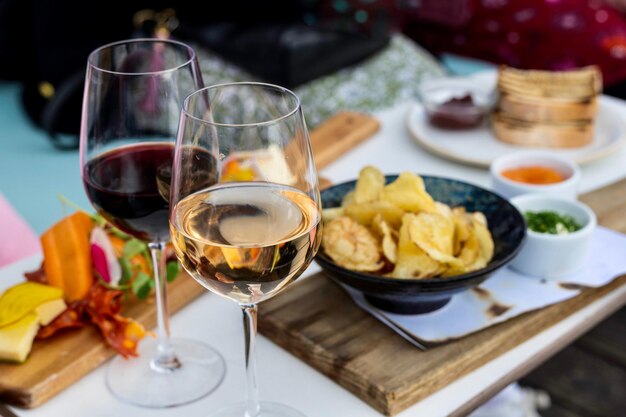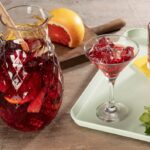0When it comes to pairing drinks with food, most people automatically think of wine. However, beer has steadily grown in popularity as a worthy companion for a variety of dishes. Both wine and beer offer a wide range of flavors, aromas, and textures that can complement or enhance different types of cuisine. So, how do you decide which is better for pairing with your favorite foods: wine or beer? Let’s break it down by looking at the characteristics of each and how they pair with different meals.
The Case for Wine
Wine has long been the go-to drink for food pairing, and for good reason. Its acidity, tannins, and broad range of flavor profiles make it a versatile companion for various dishes.
Why Wine Works:
- Acidity Balances Fat:
One of the key reasons wine pairs so well with food is its acidity, which helps cut through rich, fatty foods like cheese, steak, or creamy pasta. The acid in wine acts like a palate cleanser, refreshing your taste buds between bites. - Tannins Add Structure:
Tannins, found in red wine, add a drying sensation to the mouth, which can balance out fatty or protein-rich dishes. This is why bold red wines like Cabernet Sauvignon pair beautifully with grilled meats and roasts. - Sweetness Balances Spice:
Sweet wines like Riesling or Moscato can temper the heat in spicy dishes, such as Indian or Thai cuisine. The sweetness mellows out the spiciness, creating a balanced dining experience. - Aromatic Complexity:
Wine, especially white wine, often has subtle aromas of fruit, herbs, and flowers that can complement delicate flavors in dishes like seafood, salads, and light pasta dishes.
Ideal Wine Pairings:
- Red wine (Cabernet Sauvignon, Merlot): Grilled meats, barbecue, hearty stews
- White wine (Chardonnay, Sauvignon Blanc): Seafood, chicken, salads
- Sparkling wine (Champagne, Prosecco): Oysters, light appetizers, brunch foods
- Rosé: Grilled vegetables, light pasta, roasted chicken
- Sweet wine (Riesling, Moscato): Spicy dishes, desserts, tangy cheeses
The Case for Beer
Beer has come a long way in the culinary world, with a variety of styles that make it just as versatile as wine for food pairing. The combination of carbonation, maltiness, and bitterness allows beer to stand up to a wide array of flavors and textures.
Why Beer Works:
- Carbonation Cleanses the Palate:
The bubbles in beer act as a natural palate cleanser, especially when eating rich, greasy, or fried foods. The carbonation helps cut through fat and leaves your palate refreshed between bites. - Bitterness Balances Sweetness:
Hoppy beers like IPAs bring a sharp bitterness that contrasts well with sweet or rich foods. This bitterness can balance the sweetness of dishes like caramelized meats or desserts. - Malt Sweetness Complements Savory Dishes:
Malty beers like porters and stouts have a sweetness and richness that can complement savory dishes like roasted meats or chocolate desserts. Their depth of flavor adds complexity to heartier meals. - A Range of Styles:
From light, crisp lagers to dark, creamy stouts, beer offers a wide variety of flavors, allowing you to find the perfect match for almost any dish. Whether you’re eating spicy Mexican food, savory burgers, or delicate sushi, there’s a beer style that can enhance the dining experience.
Ideal Beer Pairings:
- Light beers (Pilsner, Lager): Salads, seafood, grilled chicken
- Hoppy beers (IPA): Spicy dishes, burgers, fried food
- Malty beers (Amber Ale, Brown Ale): Roasted meats, barbecue, pizza
- Dark beers (Stout, Porter): Chocolate desserts, stews, rich meats like lamb
- Wheat beers (Hefeweizen, Witbier): Salads, seafood, citrusy dishes
How to Decide Between Wine and Beer
When choosing between wine and beer for food pairing, the decision often comes down to the type of food and your personal preference. Here are some guidelines to help you decide:
Choose Wine If:
- You’re serving elegant, refined dishes such as seafood, poultry, or gourmet pasta.
- You want to highlight complex flavors in your food, using the acidity, tannins, or sweetness of wine to enhance the experience.
- You’re planning a formal or special occasion, where wine’s association with fine dining might feel more appropriate.
Choose Beer If:
- You’re serving casual or hearty meals, such as burgers, pizza, or barbecue.
- You want a drink with carbonation to cut through rich, fatty, or greasy foods, leaving your palate refreshed.
- You’re hosting a laid-back gathering, where beer’s relaxed and versatile nature fits the vibe of the meal.
Pairing Tips for Success
- Match Intensity: Whether you choose wine or beer, the key to a good pairing is matching the intensity of the drink with the intensity of the food. Light dishes work best with lighter drinks, while bold, rich foods pair well with fuller-bodied beverages.
- Balance Flavors: When pairing, think about balancing the flavors. If a dish is spicy, a sweet or malty drink can counterbalance it. If a dish is fatty or rich, an acidic or hoppy drink can cut through it.
- Experiment: Don’t be afraid to experiment! Both wine and beer offer a wide range of flavors and textures that can enhance your food. Try different combinations to see what works best for your palate.
In the battle of wine vs. beer for food pairing, there is no clear winner—it all depends on the dish and the occasion. Wine offers elegance, complexity, and a variety of options for more refined meals, while beer’s versatility, carbonation, and range of styles make it perfect for casual, hearty foods. The best approach is to consider the flavors and intensity of both the food and the drink, and choose the one that complements your meal the best. Whether you’re a wine lover or a beer enthusiast, there’s a perfect pairing waiting for you.








